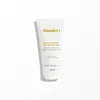What's inside
What's inside
 Key Ingredients
Key Ingredients

 Benefits
Benefits

 Concerns
Concerns

 Ingredients Side-by-side
Ingredients Side-by-side

Water
Skin ConditioningHydrated Silica
AbrasiveSodium C14-16 Olefin Sulfonate
CleansingCocamidopropyl Hydroxysultaine
CleansingPropanediol
SolventGlycerin
HumectantCitrus Grandis Peel Oil
MaskingJojoba Esters
EmollientCoco-Glucoside
CleansingCetearyl Olivate
Glycol Distearate
EmollientGlyceryl Oleate
EmollientSorbitan Olivate
EmulsifyingGlyceryl Stearate
EmollientCaprylyl Glycol
EmollientCaprylic Acid
CleansingAcrylates/C10-30 Alkyl Acrylate Crosspolymer
Emulsion StabilisingXylitol
HumectantDisodium EDTA
Sodium Hydroxide
BufferingLimonene
PerfumingSodium Chloride
MaskingBenzoic Acid
MaskingCitral
PerfumingLinalool
PerfumingTetrasodium EDTA
Citric Acid
BufferingSodium Benzoate
MaskingPotassium Sorbate
PreservativeWater, Hydrated Silica, Sodium C14-16 Olefin Sulfonate, Cocamidopropyl Hydroxysultaine, Propanediol, Glycerin, Citrus Grandis Peel Oil, Jojoba Esters, Coco-Glucoside, Cetearyl Olivate, Glycol Distearate, Glyceryl Oleate, Sorbitan Olivate, Glyceryl Stearate, Caprylyl Glycol, Caprylic Acid, Acrylates/C10-30 Alkyl Acrylate Crosspolymer, Xylitol, Disodium EDTA, Sodium Hydroxide, Limonene, Sodium Chloride, Benzoic Acid, Citral, Linalool, Tetrasodium EDTA, Citric Acid, Sodium Benzoate, Potassium Sorbate
Water
Skin ConditioningSodium C14-16 Olefin Sulfonate
CleansingPropanediol
SolventCellulose Acetate
Caprylyl/Capryl Glucoside
CleansingAcrylates Copolymer
Coco-Glucoside
CleansingGlyceryl Oleate
EmollientSodium Cocoamphoacetate
CleansingGlycerin
HumectantAloe Barbadensis Leaf Juice
Skin ConditioningCaprylic/Capric Triglyceride
MaskingBenzyl Alcohol
PerfumingCocamidopropyl Hydroxysultaine
CleansingEthylhexylglycerin
Skin ConditioningBisabolol
MaskingHydrolyzed Jojoba Esters
Skin ConditioningSclerotium Gum
Emulsion StabilisingSodium Hydroxide
BufferingRosmarinus Officinalis Leaf Oil
MaskingSalicornia Herbacea Extract
Skin ConditioningTetrasodium EDTA
Lavandula Angustifolia Oil
MaskingCamellia Oleifera Leaf Extract
AstringentAvena Sativa Kernel Extract
AbrasiveWater, Sodium C14-16 Olefin Sulfonate, Propanediol, Cellulose Acetate, Caprylyl/Capryl Glucoside, Acrylates Copolymer, Coco-Glucoside, Glyceryl Oleate, Sodium Cocoamphoacetate, Glycerin, Aloe Barbadensis Leaf Juice, Caprylic/Capric Triglyceride, Benzyl Alcohol, Cocamidopropyl Hydroxysultaine, Ethylhexylglycerin, Bisabolol, Hydrolyzed Jojoba Esters, Sclerotium Gum, Sodium Hydroxide, Rosmarinus Officinalis Leaf Oil, Salicornia Herbacea Extract, Tetrasodium EDTA, Lavandula Angustifolia Oil, Camellia Oleifera Leaf Extract, Avena Sativa Kernel Extract
Ingredients Explained
These ingredients are found in both products.
Ingredients higher up in an ingredient list are typically present in a larger amount.
Cocamidopropyl Hydroxysultaine is a synthetic cleansing agent, though it is derived from coconut oil.
It is used to enhance the texture of products by boosting lather and thickening the texture. As a cleanser, Cocamidopropyl Hydroxysultaine is mild.
Coco-Glucoside is a surfactant, or a cleansing ingredient. It is made from glucose and coconut oil.
Surfactants help gather dirt, oil, and other pollutants from your skin to be rinsed away.
This ingredient is considered gentle and non-comedogenic. However, it may still be irritating for some.
Learn more about Coco-GlucosideGlycerin is already naturally found in your skin. It helps moisturize and protect your skin.
A study from 2016 found glycerin to be more effective as a humectant than AHAs and hyaluronic acid.
As a humectant, it helps the skin stay hydrated by pulling moisture to your skin. The low molecular weight of glycerin allows it to pull moisture into the deeper layers of your skin.
Hydrated skin improves your skin barrier; Your skin barrier helps protect against irritants and bacteria.
Glycerin has also been found to have antimicrobial and antiviral properties. Due to these properties, glycerin is often used in wound and burn treatments.
In cosmetics, glycerin is usually derived from plants such as soybean or palm. However, it can also be sourced from animals, such as tallow or animal fat.
This ingredient is organic, colorless, odorless, and non-toxic.
Glycerin is the name for this ingredient in American English. British English uses Glycerol/Glycerine.
Learn more about GlycerinGlyceryl Oleate is the ester of glycerin and oleic acid. This ingredient is mainly an emollient and emulsifier.
Emollients soften and hydrate the skin by creating a thin film on top to trap in moisture. As an emulsifier, glyceryl oleate helps stabilize formulations by preventing ingredients such as oil and water from separating. According to a manufacturer, this ingredient helps helps thicken water-in-oil formulations, shower gels, and hair shampoos.
In some products, this ingredient may be used as a fragrance / perfuming ingredient. The scent of this ingredient is described to be "waxy".
Glyceryl oleate is created from oils rich in oleic acid, such as peanut oil and olive oil.
This ingredient may not be malassezia folliculitis safe.
Learn more about Glyceryl OleatePropanediol is an all-star ingredient. It softens, hydrates, and smooths the skin.
It’s often used to:
Propanediol is not likely to cause sensitivity and considered safe to use. It is derived from corn or petroleum with a clear color and no scent.
Learn more about PropanediolSodium C14-16 Olefin Sulfonate is a cleansing agent made from a mixture of long chain sulfonate salts. It can also help produce foam.
This ingredient may be drying. We recommend speaking with a professional if you have concerns.
Sodium Hydroxide is also known as lye or caustic soda. It is used to adjust the pH of products; many ingredients require a specific pH to be effective.
In small amounts, sodium hydroxide is considered safe to use. However, large amounts may cause chemical burns due to its high alkaline.
Your skin has a natural pH and acid mantle. This acid mantle helps prevent harmful bacteria from breaking through. The acid mantle also helps keep your skin hydrated.
"Alkaline" refers to a high pH level. A low pH level would be considered acidic.
Learn more about Sodium HydroxideTetrasodium EDTA is the salt formed from neutralizing ethylenediamine tetraacetic acid with sodium hydroxide. It is a chelating agent and used to prevent metal ions from binding to other ingredients. This helps keep the product and ingredients stable.
Tetrasodium EDTA comes as a white solid and is soluble in water.
Water. It's the most common cosmetic ingredient of all. You'll usually see it at the top of ingredient lists, meaning that it makes up the largest part of the product.
So why is it so popular? Water most often acts as a solvent - this means that it helps dissolve other ingredients into the formulation.
You'll also recognize water as that liquid we all need to stay alive. If you see this, drink a glass of water. Stay hydrated!
Learn more about Water